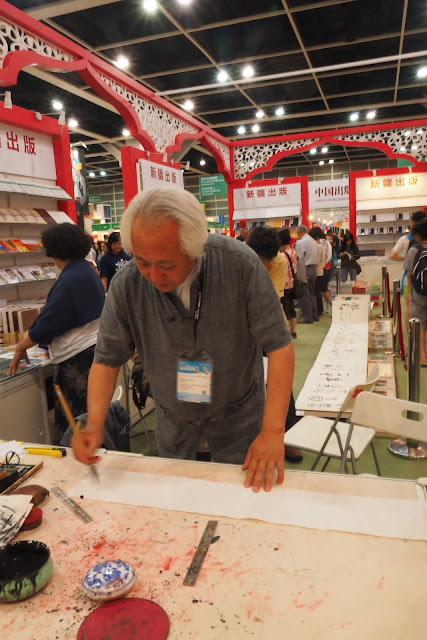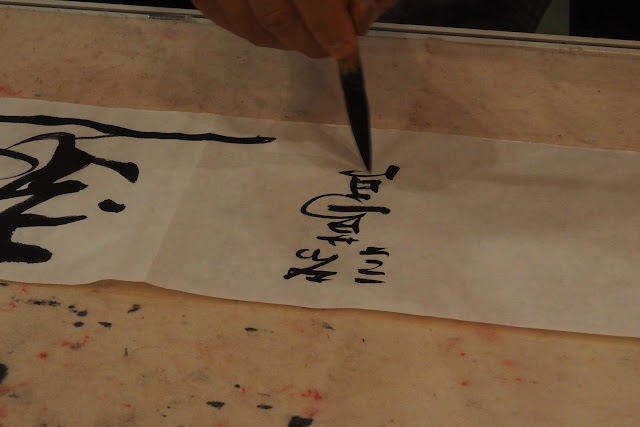Life always springs surprises upon us when you least expect it. That's
exactly what happened at this year's HK Book Exhibition. When I was
looking for some travel books for my coming trip to Xinjiang at the
booth of that province, I was astounded at the originality of some of the works there on display. The paintings were a cross between a painting and calligraphy in Chinese ink. I never saw
such work before. They were done by an old but very energetic artist from Inner Mongolia. He told me that it was the very first time that any artist's work is being sold directly by any Chinese state authorities. The price tag of
the largest calligraphic work there being sold is HK$300,000 whilst each small painting cost about HK6,000 and each single character calligraphic work $500. The artist is called 常浣成. But
he prefers to call himself 浣成, omitting his surname. I stopped at his
booth and stayed there almost an hour, admiring his
calligraphic-painting, talking to him and watching him create some
work on the spot.

This is a frog
and this is a chicken
This is a hill
This is a dust storm
A Chinese couplet
An ox
The arrival of blessing
a chariot
another chariot
Two riders
Another painting: what is the Chinese character?
Another chariot in Chinese character?
The artist telling us that he will produce another calligraphic work
The artist starting to write
He has written some 3 characters
nearly finished
Japanese made Chinese ink cost $500 a bottle
He is dipping his brush into the Chinese ink
He scrapped the previous one because he thought it was not good enough and is starting to write a new one.
beginning to write
Art in action
Continuing
Silence. He wrote this because I asked him whether he needed to calm himself first before he wrote. This is his reply to my question.
Continuing his calligraphic work
nearly done
the final character
signing his name
half done
adding the name of the poet
identifying the source
writing the name of the poet from which he took the words
signing his own name
putting his seal on it
stamping another seal to identify the calligraphic work
done!
the sealing material
the final seal
The completed work
During the discussions, he told me that he did not wish to do any realistic painting any more and told me that when he first started, he did paint in that style and showed me some of the realistic paintings he did on his I-phone. He said there was no point because the camera can do realistic representations even better. So he thought of a new way of painting which shows the spirit of Chinese civilization and the thought of using Chinese characters which originally were pictograms. But he wished to give more life to the characters, so he modified the way the characters are written a little so that they may the better suggest their sense in picture form. He knew all kinds of style of writing Chinese characters, including 甲骨文 (bone writing),篆書,岩文, 碑文, 印章文, 行草 , 篆書,行草, 楷書。He would think of different ways of writing the same Chinese character so as to achieve the best combination of sense and shape and sometimes would mix such writing style so as to achieve what he thinks is the best way of bringing out the sense of the character. thus achieving the best possible combination of form and meaning. According to 謝赫, in his classic 《古畫品錄》, the aim of Chinese painting is to bring out in the relevant painting the most vivid sense of "life" (<「氣韻生動」) in whatever is being painted or the spirit of life which according to Chinese philosophy is chi "氣". If that is true, then 浣成 has certainly achieved that. I don't know how famous he is internationally. But I believe his work will be more and more recognized in the West because the kind of innovation he is introducing, in breaking down the boundary between painting and calligraphy, the free juxtapositioning of different styles of writing Chinese characters from different historical periods and the use of color to enhance the purely pictorial element of his calligraphy creates a most contemporary feel which paradoxically is teeming with the spirit of the most ancient form of Chinese writing, unfortunately progressively lost in the modern drive for simplification in the reform of modern Chinese character-formation formation, something which ties in perfectly with the "postmodernist" emphasis on the obliteration of boundaries of space and time. I have no doubt about it. I think that the way he combines the "form" of Chinese character in its different historical styles with its physical shape is unprecedented. In that sense, he is a truly revolutionary painter-calligrapher which I think may inspire generations of young Chinese artists, racking their brain for creating new ways of doing Chinese calligraphy and Chinese painting , to follow suit. But I wonder if the newer artist will know as much about the shapes of ancient Chinese characters as he does. If they don't then they will be unable to fully exploit the pictorial shape of various forms of traditional Chinese styles of writing as effectively and as beautifully as 浣成 has done.
During the discussions, he told me that he did not wish to do any realistic painting any more and told me that when he first started, he did paint in that style and showed me some of the realistic paintings he did on his I-phone. He said there was no point because the camera can do realistic representations even better. So he thought of a new way of painting which shows the spirit of Chinese civilization and the thought of using Chinese characters which originally were pictograms. But he wished to give more life to the characters, so he modified the way the characters are written a little so that they may the better suggest their sense in picture form. He knew all kinds of style of writing Chinese characters, including 甲骨文 (bone writing),篆書,岩文, 碑文, 印章文, 行草 , 篆書,行草, 楷書。He would think of different ways of writing the same Chinese character so as to achieve the best combination of sense and shape and sometimes would mix such writing style so as to achieve what he thinks is the best way of bringing out the sense of the character. thus achieving the best possible combination of form and meaning. According to 謝赫, in his classic 《古畫品錄》, the aim of Chinese painting is to bring out in the relevant painting the most vivid sense of "life" (<「氣韻生動」) in whatever is being painted or the spirit of life which according to Chinese philosophy is chi "氣". If that is true, then 浣成 has certainly achieved that. I don't know how famous he is internationally. But I believe his work will be more and more recognized in the West because the kind of innovation he is introducing, in breaking down the boundary between painting and calligraphy, the free juxtapositioning of different styles of writing Chinese characters from different historical periods and the use of color to enhance the purely pictorial element of his calligraphy creates a most contemporary feel which paradoxically is teeming with the spirit of the most ancient form of Chinese writing, unfortunately progressively lost in the modern drive for simplification in the reform of modern Chinese character-formation formation, something which ties in perfectly with the "postmodernist" emphasis on the obliteration of boundaries of space and time. I have no doubt about it. I think that the way he combines the "form" of Chinese character in its different historical styles with its physical shape is unprecedented. In that sense, he is a truly revolutionary painter-calligrapher which I think may inspire generations of young Chinese artists, racking their brain for creating new ways of doing Chinese calligraphy and Chinese painting , to follow suit. But I wonder if the newer artist will know as much about the shapes of ancient Chinese characters as he does. If they don't then they will be unable to fully exploit the pictorial shape of various forms of traditional Chinese styles of writing as effectively and as beautifully as 浣成 has done.







































沒有留言:
張貼留言